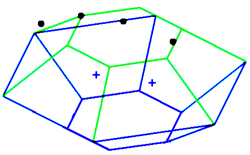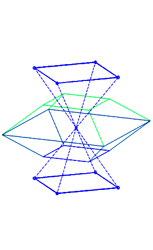Multiview Mirror Pyramid Panoramic Cameras
 |
 |
|---|---|
| (a) | (b) |
Figure 1. The experimental multiview panoramic camera. (a) The conceptual design. (b) The physical implementation utilizing four cameras and two mirror faces to produce two views.
Panoramic images and video are useful in many applications such as special effects, immersive virtual reality environments, and video games. Among the numerous devices proposed for capturing panoramas, mirror pyramid-based camera systems are a promising approach for video rate capture, as they offer single-viewpoint imaging, and use only flat mirrors that are easier to produce than curved mirrors. To date, the designs proposed typically capture panoramas from a single viewpoint.
A mirror pyramid consists of a set of flat mirror faces arranged around an axis of symmetry, inclined to form a pyramid. By strategically positioning a number of conventional cameras around a mirror pyramid, the viewpoints for the individual cameras’ mirror images can be colocated at a single point within the pyramid, effectively forming a virtual camera with a wide field of view.
Mirror pyramid-based panoramic cameras have a number of attractive properties, including
- single-viewpoint imaging
- high resolution, and
- video rate capture
Previous designs realize a single viewpoint within each mirror pyramid. In order to capture panoramas from multiple viewpoints with these designs, the entire physical setup would need to be relocated or duplicated. The former solution lacks the capability of video rate imaging, and the latter leads to bulky designs due to the multiple mirror pyramids.
In our paper we proposed a method for generalizing existing designs such that multiple viewpoints can be created in a single mirror pyramid. This enables simultaneous multiview panoramic video rate imaging with a compact design.
 |
 |
 |
|---|---|---|
| (a) | (b) | (c) |
Figure 2. Variation in the physical camera position with viewpoint position. (a) Viewpoint is centered in four-sided pyramid, shown with the corresponding eight camera positions. (b) Translated viewpoints marked A, B, and C are shown with correspondingly marked physical camera positions. (c) Same as (b), but with a mirror pyramid with a large number of faces to show how the shape changes as the viewpoint translates.
Experiments
 |
 |
|---|---|
 |
 |
Figure 3. Captured Images

Figure 4. Stitched Image Pair
Collaborators
Publications
-
Kar-Han Tan, Hong Hua and Narendra Ahuja, “Multiview panoramic cameras using mirror pyramids,” in IEEE Transactions on Pattern Analysis and Machine Intelligence, vol. 26, no. 7, pp. 941-946, July 2004. DOI PDF
-
Kar-Han Tan, Hong Hua and Narendra Ahuja, “Multiview panoramic cameras using a mirror pyramid,” Third Workshop on Omnidirectional Vision, pp. 87-93, 2002. DOI PDF
Citation
@ARTICLE{tan2004multiview,
author={Kar-Han Tan and Hong Hua and Narendra Ahuja},
journal={IEEE Transactions on Pattern Analysis and Machine Intelligence},
title={Multiview panoramic cameras using mirror pyramids},
year={2004},
volume={26},
number={7},
pages={941-946},
keywords={image resolution;image sensors;mirrors;stereo image processing;video cameras;FOV;cameras mirror images;field of view;image resolution;imaging geometry;mirror pyramid cameras;multiview panoramic cameras;optical axes;panoramic video rate imaging;planar mirror faces;sensor utilization;single viewpoint imaging;symmetry axis;video rate capture;virtual camera;Cameras;Design methodology;Geometry;High-resolution imaging;Image resolution;Mirrors;Optical imaging;Optical sensors;Prototypes;Solid modeling;Panoramic cameras;catadioptric systems;mirror pyramids;multiview panoramic imaging;omnidirectional imaging and video capture;stereoscopic cameras.;Algorithms;Artificial Intelligence;Image Enhancement;Image Interpretation, Computer-Assisted;Imaging, Three-Dimensional;Pattern Recognition, Automated;Photography},
doi={10.1109/TPAMI.2004.33},
ISSN={0162-8828},
month={July},
note={\url{https://karhan-tan.github.io/Pyramid}} }